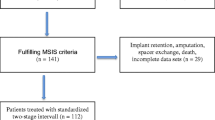Abstract
A retrospective analysis of 52 patients with hip pain following total hip replacement was made. Each of them was evaluated by plain radiographs, technetium 99m pyrophosphate scans, arthrography with plain film subtraction technique, and culture of joint fluid. In 30 cases there was evidence of prosthetic loosening, and in 21 of these lymphangeal opacification during arthrography was seen. In 15 cases with lymphongeal opacification the diagnosis of prosthetic loosening was subsequently confirmed by prosthetic revision. In none of the 22 cases in which no evidence of prosthetic loosening was seen was there lymphatic opacification. It is concluded that lymphatic opacification during arthrography for pain following total hip prosthesis is a valuable ancillary sign of loosening.
Similar content being viewed by others
References
Anderson LS, Staple TW (1973) Arthrography of total hip replacement using subtraction technique. Radiology 109:470
Coren GS, Curtis G, Dalinka M (1975) Lymphatic visualisation during hip arthrography. Radiology 115:621
Dussault RG, Goldman AB, Ghelman B (1975) Radiological diagnosis of loosening and infection in hip prostheses. J Can Assoc Radiol 28:117
Gelman MI, Coleman RE, Stevens PM, Davey BW (1978) Radiography, radionuclide imaging, and arthrography in the evaluation of total hip and knee replacement. Radiology 128:677
Lull RJ, Utz JA, Jackson JH, et al. (1983) Radionuclide evaluation of joint disease. In: Freedman LM, Weissmann HS (eds) Nuclear medicine annual. Raven, New York, p 281
Mountford PJ (1989) Role of technetium-99m phosphonate bone and indium-111 leucocyte scanning for detecting the infected hip prosthesis. J Nucl Med 30:562
O'Neill DA, Harris WH (1984) Failed total hip replacement: assessment by plain radiographs, arthrograms, and aspiration of the hip joint. J Bone Joint Surg [Am] 66:540
Oswald SG, Van Nostrand D, Savory CG, Callaghan JJ (1989) Three-phase bone scan and indium white blood cell scintigraphy following porous coated hip arthroplasty: a prospective study of the prosthetic tip. J Nucl Med 30:1321
Phillips WC, Kattapuram SV (1982) Prosthetic hip replacement: plain films and arthrography for component loosening. AJR 138:677
Salvati EA, Freiberger RH, Wilson PD (1971) Arthrography for complications of total hip replacement. J Bone Joint Surg [Am] 53:701
Utz JA, Lull RJ, Galvin EG (1986) Asymptomatic total hip prosthesis: natural history determined using Tc-99m MDP bone scans. Radiology 161:509
Weiss PE, Mall JC, Hoffer PB, Murray WR, Rodrigo JJ, Genant HK (1979) 99m Tc-methylene diphosphonate bone imaging in the evaluation of total hip prostheses. Radiology 133:727
Weissman BN (1983) The radiology of total hip replacement. Orthop Clin North Am 14:171
Author information
Authors and Affiliations
Rights and permissions
About this article
Cite this article
Bloom, R.A., Gheorghiu, D. & Krausz, Y. Lymphatic opacification in the prosthetic hip. Skeletal Radiol. 20, 43–45 (1991). https://doi.org/10.1007/BF00243721
Issue Date:
DOI: https://doi.org/10.1007/BF00243721




